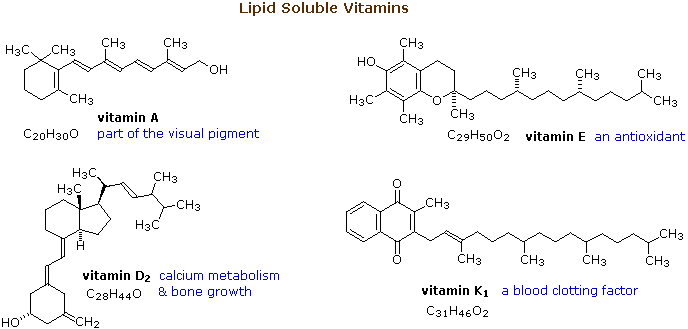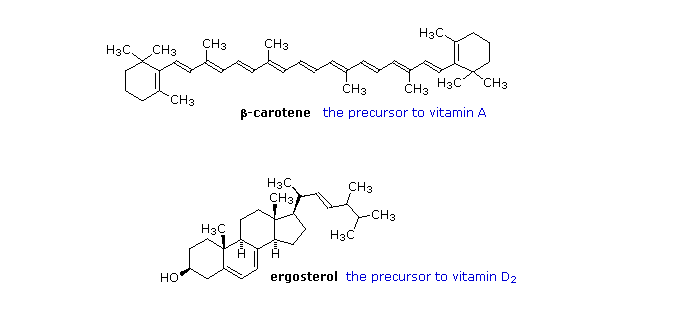


 علم الكيمياء
علم الكيمياء 
 الكيمياء التحليلية
الكيمياء التحليلية 
 الكيمياء الحياتية
الكيمياء الحياتية 
 الكيمياء العضوية
الكيمياء العضوية 
 الكيمياء الفيزيائية
الكيمياء الفيزيائية
 الكيمياء اللاعضوية
الكيمياء اللاعضوية 
 مواضيع اخرى في الكيمياء
مواضيع اخرى في الكيمياء
 الكيمياء الصناعية
الكيمياء الصناعية |
Read More
Date: 23-12-2019
Date: 18-12-2019
Date: 21-12-2019
|
The essential dietary substances called vitamins are commonly classified as "water soluble" or "fat soluble". Water soluble vitamins, such as vitamin C, are rapidly eliminated from the body and their dietary levels need to be relatively high. The recommended daily allotment (RDA) of vitamin C is 100 mg, and amounts as large as 2 to 3 g are taken by many people without adverse effects. The lipid soluble vitamins, shown in the diagram below, are not as easily eliminated and may accumulate to toxic levels if consumed in large quantity. The RDA for these vitamins are:
Vitamin A 800 μg ( upper limit ca. 3000 μg)
Vitamin D 5 to 10 μg ( upper limit ca. 2000 μg)
Vitamin E 15 mg ( upper limit ca. 1 g)
Vitamin K 110 μg ( upper limit not specified)
From this data it is clear that vitamins A and D, while essential to good health in proper amounts, can be very toxic. Vitamin D, for example, is used as a rat poison, and in equal weight is more than 100 times as poisonous as sodium cyanide.


From the structures shown here, it should be clear that these compounds have more than a solubility connection with lipids. Vitamins A is a terpene, and vitamins E and K have long terpene chains attached to an aromatic moiety. The structure of vitamin D can be described as a steroid in which ring B is cut open and the remaining three rings remain unchanged. The precursors of vitamins A and D have been identified as the tetraterpene beta-carotene and the steroid ergosterol, respectively.



|
|
|
|
دراسة يابانية لتقليل مخاطر أمراض المواليد منخفضي الوزن
|
|
|
|
|
|
|
اكتشاف أكبر مرجان في العالم قبالة سواحل جزر سليمان
|
|
|
|
|
|
|
اتحاد كليات الطب الملكية البريطانية يشيد بالمستوى العلمي لطلبة جامعة العميد وبيئتها التعليمية
|
|
|